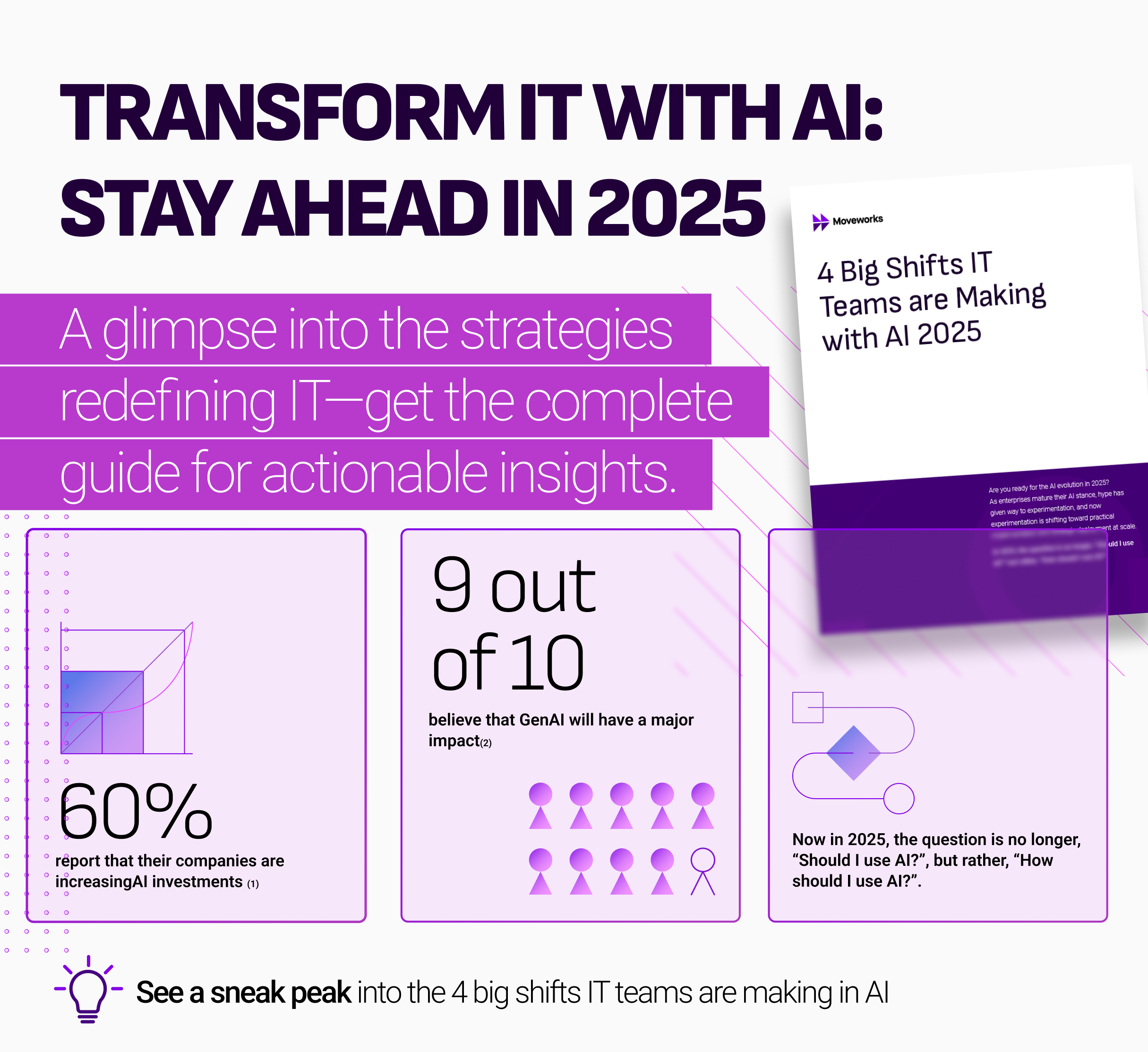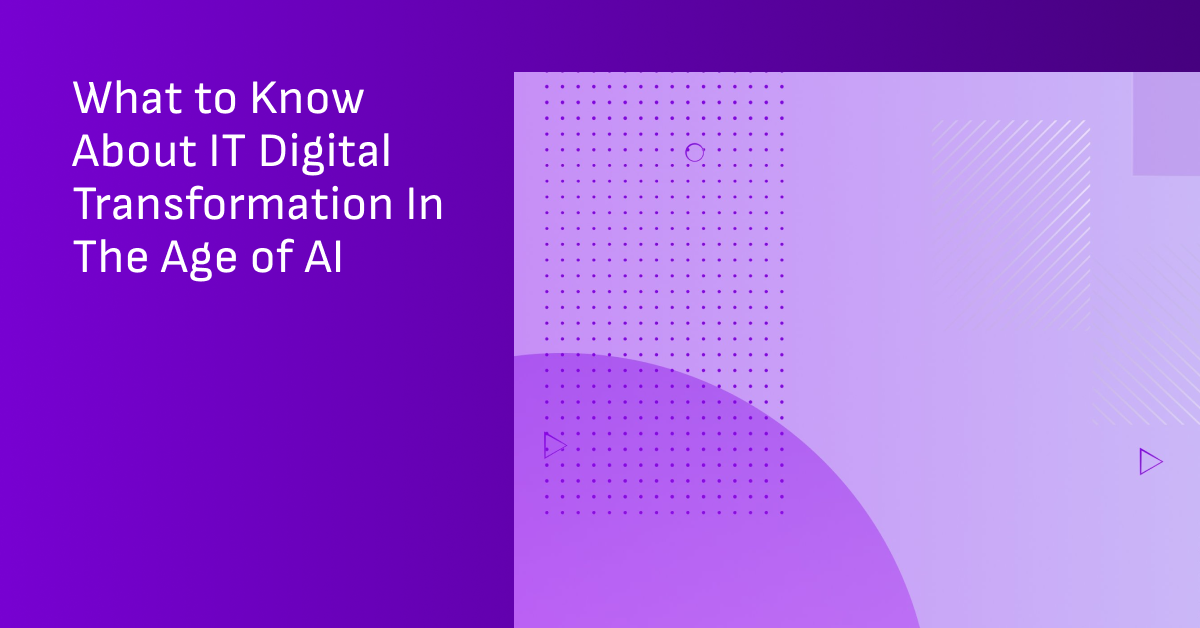Table of contents
AI holds the key to helping you modernize your IT infrastructure and processes. Whether you’re looking to seamlessly integrate new digital tools, significantly improve operational efficiency, or maintain a competitive edge in today's rapidly evolving technological landscape.
You already know that updating your IT systems and implementing newer solutions is essential to building a more capable and agile business. And 81% of business leaders also believe that digital transformation strategies are the answer to accelerating growth.
However, for truly successful transformation, you’ll also want a deep understanding of how to align AI technology with your bigger business goals.
Keep reading as we share practical guidance on integrating new digital tools, improving operational efficiency, and growing your business into an agile, innovative powerhouse through strategic IT and AI investments.
What is digital transformation?
A digital transformation involves a fundamental shift in how businesses operate, modifying or replacing existing systems, processes, and technology to drive continuous growth. This isn't merely about fixing your processes or adopting the latest gadgets; it's about strategically re-engineering your teams and your tech to address specific pain points.
Digital optimizations have accelarated since the COVID-19 pandemic, highlighting the urgent need for IT modernization. And the influx of AI-powered tools that can easily scale and streamline tasks, only fuels this drive.
Artificial intelligence plays a critical role in transformation, and most businesses are looking for ways to integrate AI into their operations. However, true digital transformation goes beyond mere technology adoption. It necessitates a holistic approach, encompassing a strategic overhaul of IT infrastructure and processes.to foster a more agile, innovation-driven company mindset.
Why enterprises need digital transformation
Small-scale, department-specific digital evolutions are a natural part of doing business. However, taking a broader, holistic approach to digital transformation on an enterprise-wide level is often far more impactful. This ensures that no one area of the business gets left behind and keeps everyone focused on future readiness rather than playing catch-up.
Here’s a closer look at why a strategic approach to digital transformation can benefit your business:
Automates and improves digital operations
- Accelerate operations and minimize errors: IT digital transformation leverages automation to streamline processes, not replace people. This creates powerful human-machine collaborations that minimize human errors and free your team to focus on high-value tasks, like exceptional customer service and strategic problem-solving.
- Unlock productivity and gain a competitive edge: By automating workflows, digital transformation eliminates costly productivity bottlenecks. This allows your teams to work smarter, not harder, leading to faster growth and a stronger competitive position.
Enhances customer and user experiences
- Deliver seamless and memorable customer journeys: Digital transformation equips you with the tools to meet today's customer expectations for speed and efficiency. This results in superior user experiences and drives improved business outcomes.
- Enhance employee productivity and collaboration: By automating repetitive tasks, like IT ticket routing, and implementing efficient communication platforms like Slack and integrated collaboration tools like Microsoft Teams, digital transformation empowers your employees to focus on critical duties and achieve more with existing resources.
Scales data management and improves insights
- Transform data into actionable insights: Digital transformation provides the scalable solutions needed to manage and analyze the increasing volume of data from diverse sources. This enables you to gain meaningful insights into your business and customers, driving informed decision-making.
- Support growth and innovation with scalable data management: By modernizing data management even when relying on numerous data sources digital transformation ensures your infrastructure can support the growing number of digital applications and AI technologies, allowing you to capitalize on emerging opportunities.
Supports IT modernization
Your business’s IT capabilities determine its overall efficiency. Digital transformations allow you to modernize your infrastructure to support current business needs and better position you for scalable growth.
IT modernization helps enterprises address issues such as:
- Operational inefficiencies: Working with outdated systems can lead to system compatibility issues and increased reliance on manual tasks. IT modernization provides an updated ecosystem that makes it easier to automate more business functions while streamlining operations.
- Slower response times: Outdated IT systems can lead to slower support workflows and frustrating customer experiences. Modernizing your IT systems and processes provides more opportunities for improving service response times and gives employees the tools they need to stay productive.
- Growth limitations: The state of your IT infrastructure directly impacts your growth abilities. A more modern backend allows your business to remain agile while giving you the room to expand your operations with limited disruption.
AI is supercharging IT digital transformation
Modern business environments are becoming increasingly intelligent. AI technology deployments are a key driver behind this evolution, helping enterprises get more done in less time.
These transformations are typically approached in two phases - internal process improvements and external support.
Behind closed doors, new communication tools and system support solutions can help employees improve their productivity and output quality. When it comes to external enhancements, innovations like self-service support chatbots allow for more personalized customer experiences and help to improve long-term brand loyalty.
In the past, achieving these improvements meant transitioning to cloud computing providers and making new products and services more accessible to employees and customers. But now, AI technology is being used to supercharge digital transformation efforts in a number of ways, allowing businesses to:
- Enable intelligent automation that can handle complex business tasks on its own
- Proactively predict and resolve business issues, such as systems outages, security risks, or customer issues
- Provide more personalized and supportive experiences for both employees and customers
Agentic AI is leading the charge behind this push for AI-powered transformations. Unlike traditional AI integrations, which have limitations in scope and abilities, sophisticated agentic AI systems allow for much more intelligent and flexible deployments.
By leveraging AI assistants that can learn over time, adapt, and make decisions without human intervention, businesses can transform their entire operations faster and more efficiently than ever before.

The role of IT in enterprise digital transformation
IT restructuring plays a critical role when planning a digital transformation. This includes balancing integrating new digital technologies with the change management necessary to facilitate a seamless business transition.
Owning digital transformation in IT
A large part of digital transformation is introducing new technologies to improve operations at all levels, especially service desk support. AI-powered automation can help businesses in this area by deploying a solution capable of automatically resolving common issues as they arise and minimizing IT teams' administrative workloads.
AI-powered solutions analyze employee requests using machine learning (ML) and natural language processing (NLP). This technology allows them to run pragmatic responses, such as automatically resetting user passwords, configuring new software, or providing access permissions to systems and applications.
Employees benefit from real-time support when needed, allowing IT teams to focus their efforts on other critical aspects of the business that require a level of nuance that only humans can address.
A leading website design platform provides a great example of the benefits of modernizing IT environments. As the company transitioned its web support from an outside party to in-house, it faced new growth challenges, which created a significant load on internal teams.
However, by implementing an AI-powered service desk solution, the company was able to automate 50% of all its IT issues while achieving a 90+ Net Promoter Score (NPS).
Supporting digital transformation across the enterprise
IT teams are vital resources for ensuring the enterprise-wide adoption of new digital transformation initiatives. Positioning your IT departments to train and empower employees to use the latest technology deployments helps ensure company-wide adoption and better investment returns.
For example, IT staff can work with developers and research teams to implement AI agent builders for all business areas. This allows all employees — from HR and sales to finance and customer support — to leverage new automation to simplify and improve their daily tasks. They'll also have the tools and training to troubleshoot any solutions they use if and when problems arise.
Digital transformation strategy: Setting teams up for success
Before starting your digital transformation journey, you'll need to have a plan of action. You’ll want to scope and define your digital systems roadmap, ensure you address data management and security considerations, and figure out how to shift your culture and processes toward true transformation.
Creating this clear strategy helps you evaluate how you can evolve your infrastructure and surrounding business processes while providing a progressive path forward to execute it.
Below are some key elements all digital transformation strategies should include:
Digital systems roadmap
Building a clear digital systems roadmap is critical to maximizing the business value of your transformation. Your roadmap should document your existing legacy systems and supporting workflows, helping you better map out your transition plans for new implementations.
This process is critical for success since it helps you proactively identify compatibility or data integration challenges that could slow your progress. It also helps to minimize any disruptions to your day-to-day operations.
Digital systems roadmaps also clarify your development teams when building out new AI deployments. With an outline of business functions already in place, it becomes easier to prioritize where and how intelligent automation can best be utilized and configured.
Data management and security considerations
All digital transformation strategies require closely examining certain data management and security elements. Since most AI tools integrate with your applications and potentially sensitive internal information, businesses must ensure their implementations are safe and ethical.
Failure to exercise caution during a digital transformation could lead to increased security vulnerabilities, regulatory compliance breaches, and even reputational damages. To avoid this from happening, some important things to consider include:
- Data privacy and compliance: Data privacy becomes critical because of the extensive amount of data collected and used in modern systems and applications. This means businesses need protections like data description, strict access controls, and regularly scheduled audits to meet strict regulatory compliance requirements.
- Existing algorithm bias: While AI technology continues to improve, some solutions use outdated training data or may have algorithms that exhibit inaccurate biases when executing business automation. It's important to research where these biases can emerge and ensure you use the correct training data before implementing company-wide integrations.
- Security requirements: Digital security becomes a critical concern as a business modernizes its infrastructure. A large part of digital transformation planning should focus on implementing effective security controls and policies to minimize vulnerabilities and better protect larger attack surfaces.
Workplace culture alignment
Successfully executing a digital transformation means more than just adding new software and systems. It also means improving the value you bring to your customers. However, to do this effectively, you need to be willing to iterate and improve your company culture.
Rather than entrusting organizational changes to a single department, it's essential to establish a collaborative environment where everyone feels invested in helping the business evolve.
A big part of this initiative is helping all employees embrace new challenges and experimentation. Collaborating to identify new ways of working and implementing and testing new technologies ensures that everyone gets equal value from the transformation process.
Success measurements
Digital transformations don't happen overnight. Many businesses gradually transition their systems and processes over several weeks or months. This means it's important to establish trackable metrics during the planning stages to help gauge the effectiveness of your efforts over time.
Quantifiable targets are important to ensure that your transformation initiatives are meeting your business goals. This includes gauging the accuracy and efficiency of your AI-driven processes and their impact on your teams’ performance.
When deciding on applicable metrics to put in place, below are some key areas to consider:
- Operational efficiency: Tracking metrics like time saved on tasks and error percentages will help you see if your business improvements provide the support your team needs to increase productivity and efficiency.
- Customer response: Monitoring changes in customer response times and satisfaction scores ensures that your changes add value to customers and help reduce the ticket backlog for IT teams.
- Business resolution timeframes: In addition to measuring operational efficiency over time, tracking business agility is another critical metric. This will help you assess the quality of the business insights you can extract from AI solutions and their ability to help you make more data-driven decisions.
- Process automation capabilities: A big part of digital transformations is enabling new business automation. Tracking the number of manual versus automated business tasks will ensure your business is trending in the right direction when it comes to freeing up more time for employees.
An AI Assistant for successful digital transformation
IT digital transformation is not just about implementing new technology; it's about strategically leveraging it to unlock tangible benefits that propel your business forward.
Select an AI platform that integrates ethical AI frameworks and prioritizes transparency and fairness for responsible digital transformation. Simultaneously, carefully consider robust data governance policies to protect privacy and mitigate potential biases within automated systems as you grow.
Ultimately, embracing digital transformation should allow you to adapt to the evolving demands of the modern marketplace, enabling your organization to remain agile, innovative, and poised for success.
Moveworks AI Assistant accelerates the time to value of digital transformation. Here's how:
- Get faster ROI on your AI investment: Our highly advanced and secure solution that works out of the box — no model tuning, scripting, or dialog flows required.
- Eliminate workflow roadblocks: Stop wasting time on manual work. Give employees one intuitive interface to find the right information, automate tasks end-to-end, and be much more productive.
- Boost employee productivity: Use agentic AI to drive greater output – summarize files, book meetings, and apply world knowledge to work more efficiently and effectively.
Are you ready to start planning your own digital transformation while future-proofing your AI strategy? Download the 4 Big Shifts in AI for IT leaders in 2025.



